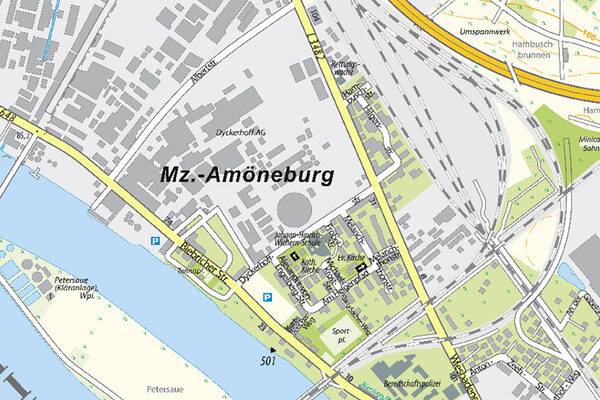Amöneburg - Industrial history on the Rhine
Amöneburg belongs politically to the city of Wiesbaden and is administered by the local administration in Biebrich town hall.
Boundary lines
Amöneburg lies on a historical borderline that has separated different territories over the centuries. In the Middle Ages, it marked the border between Kurmainz and Nassau. Later, it was the dividing line between the Grand Duchy of Hesse and the Duchy of Nassau, before separating the People's State of Hesse from Prussia in the 20th century.
The first child
Amoeneburg's first residential building was built in 1858, where Katharina Partheymüller was born on March 12, 1859 as the first child in the newly founded district. This marked the beginning of Amoeneburg's development as a residential and industrial location.
Industrialization and visionary entrepreneurs
The development of Amöneburg began in the middle of the 19th century in the course of industrialization. An early pioneer was the Rheinische Glasfabrik, which was founded here in 1852. Heinrich and Eugen Albert founded a factory for the production of artificial fertilizers in 1861. Wilhelm Gustav Dyckerhoff followed in 1864 with his sons Gustav and Rudolf and built a cement factory, which still exists today and brought Amoeneburg international renown. The growth of the industry attracted more and more people to Amoeneburg.
Change after the Second World War
The Second World War also brought destruction to Amöneburg, including the blowing up of the Kaiserbrücke bridge, which had been opened in 1904. Nevertheless, reconstruction and the economic miracle years followed, which ensured economic success for the companies based here and a good existence for the residents. The municipality continued to expand and developed a modern infrastructure.
The AKK conflict
Amöneburg, the smallest AKK district, looks back on a special history: the district originally belonged to Mainz, but after the Second World War, the Allies defined the Rhine as the border between the US and French occupation zones. The Mainz suburbs of Amöneburg, Kastel and Kostheim (AKK) on the right bank of the Rhine were assigned to Wiesbaden - a decision that still stands today and led to the so-called "AKK conflict". Now viewed rather humorously in the context of carnival, the saying "There's also Mainz on the right bank of the Rhine" actually existed at the time.
Historical highlight
A votive stone from the year 224 AD proves that Amöneburg was already inhabited in Roman times.
